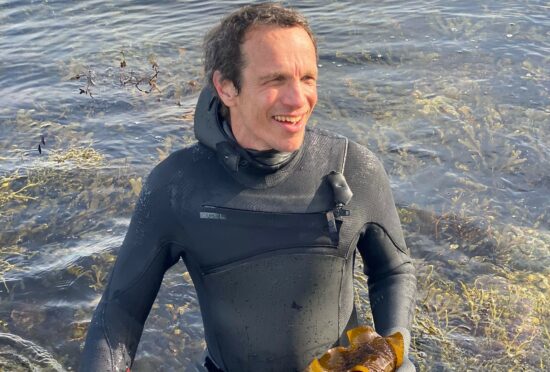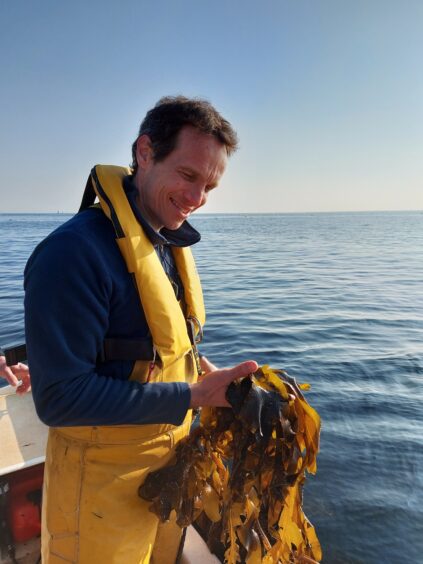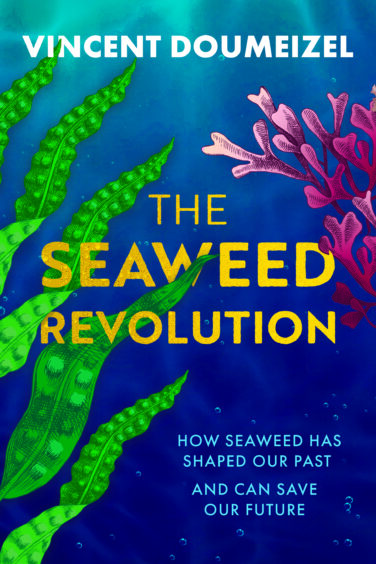
Sustainability expert and United Nations adviser Vincent Doumeizel, author of The Seaweed Revolution, is one of the guest speakers at this month’s Edinburgh Science Festival.
Here, he tells Ross Crae why what’s at the bottom of our oceans has the power to change the world.
How did you start working on seaweed projects?
I worked in the food industry for 20 years and eventually realised that there was no way to beat the fast growing population, with 300,000 additional people to feed every day.
Food systems are among the biggest contributor to global warming, soil depletion, biodiversity loss, and modern slavery. We have to produce more and more food but we have no arable land left and the yields of the big crops are declining because the land is exhausted.
Why turn to the sea?
Ocean covers 70% of our planet and only contributes to 2% of our food. The other 98% comes from over-exploited land. We have to grow more food from the ocean, but sustainably. If you want to repair the ocean instead of destroying it as we do right now, seaweed’s the best place to start.
What uses can seaweed have for humans?
It can be nutritious food, full of very interesting, healthy compounds, but the full scope of its potential is that it can also be anti-inflammatory, antibacterial, antiviral, anaesthetic, antifungal, and the most powerful probiotic we have on the planet.
Seaweed can provide a disruptive innovation in medicine to address new diseases and also things like cancer and Alzheimer’s. We have amazing innovation right now in that field, still at an early stage, but very promising.
It can also replace plastic, cotton and also help restore biodiversity in the ocean, repair the ocean, sequester more carbon than any land forests and provides a source of revenues to coastal communities where fishing is declining and disappearing.
We know from experience that in these communities the first ones who will benefit from this new industry are woman and the most vulnerable people. That’s good because it’s a seaweed revolution and you don’t do a revolution without addressing and improving social justice in the world.
And it can help with farming issues too?
It makes more sense to feed fish stock with local seaweed, rather than with soy and GMOs that come from the other side of the planet and that are deforesting the Amazon. It also makes sense for livestock on land. The biggest potential might be as a fertiliser, replacing all the phosphorus, phosphate and nitrogen.
Seaweed’s not a silver bullet, but it’s really like a jack of all trades. There are many projects but they are highly fragmented, which is why we have created a global seaweed coalition with the Lloyd’s Register Foundation to share knowledge, support new projects financially and accelerate change.
Does seaweed need a rebrand?
I think the name is a disservice. People think it’s smelly, slimy, unsexy. It feels like something unwanted that grows in your garden. It would be better to call them sea vegetables, like in Japan, so that people can understand how good and delicious they are.
What is humanity’s history with seaweed?
Over thousands of generations, science has established clearly that a massive intake of polyunsaturated fatty acids only present in seaweed and fish oil have triggered the genetic modification of our brains to become so big compared to our body mass.
The oldest trace of seaweed consumption is in Latin America in Chile and 15,000 years old. Seaweed was taken out of our history with the start of agriculture in Mesopotamia, and then with the rise of the Greeks and Romans.
They decided to focus on land agriculture. The Mediterranean region is really not a good place for seaweed. It’s closed, polluted, very warm, there’s no current there. Seaweed doesn’t like it and when there is some, it might be quite problematic because it’s more like an invasive species.
The only place where we were we kept the tradition was Japan and North China – the only places that weren’t colonialised by European descendants. I think it’s time now to reconnect with seaweed.
What is your favourite seaweed dish?
I love seaweed tartare. Mix dry seaweed with olive oil, vinegar, sesame oil, some lemon. Put that on bread as an apéritif, it’s delicious. I like pancakes with seaweed too.
I love to share seaweed with my kids as a food and also as a concept, because I think right now we are feeding our kids with fears and drama. We should feed them with hopes and solution. Seaweed is a very good hope for the planet.
The Seaweed Revolution, Edinburgh Science Festival, April 5, sciencefestival.co.uk

Enjoy the convenience of having The Sunday Post delivered as a digital ePaper straight to your smartphone, tablet or computer.
Subscribe for only £5.49 a month and enjoy all the benefits of the printed paper as a digital replica.
Subscribe
